PROBLEMS ON INCENTER OF TRIANGLE
Subscribe to our ▶️ YouTube channel 🔴 for the latest videos, updates, and tips.
Subscribe to our ▶️ YouTube channel 🔴 for the latest videos, updates, and tips.
- The incenter is formed by connecting the three angle bisectors
- The three angle bisectors of a triangle are concurrent at a point equidistant from the sides of a triangle.
- These are the radii of the incircle
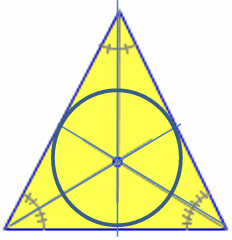
Problem 1 :
Point G is the incenter of ∆ACE. Find each indicated measure.
a) AF b) BG
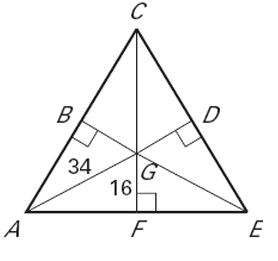
Solution :
Here G is the incenter and AC, AE and CE are sides of the triangle.
The distance between incenter and sides of the triangle will be equal. So, BG = GF = DG .
In triangle AGF,
<AFG = 90
AG2 = GF2 + AF2
342 = 162 + AF2
AF2 = 342 - 162
AF2 = 1156 - 256
AF2 = 900
AF = √900
AF = 30 and BG = 30
Problem 2 :
Point P is the incenter of ∆HKM. Find each indicated measure.
a) PN b) JP
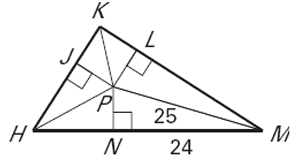
Solution :
Since P is the incenter of the triangle, PN = PJ = PL
In triangle PNM,
PM2 = PN2 + NM2
252 = PN2 + 242
625 - 576 = PN2
PN2 = 49
PN = 7 = JP
Problem 3 :
Point A is the incenter of triangle PQR. Find each measure below.
i) <ARU ii) <QPK
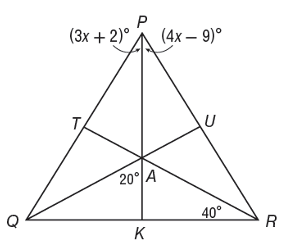
Solution :
Since A is the incenter, it must the point of intersection of all angle bisectors of the triangle.
TR is the angle bisector, then <KRA = <ARU = 40 degree
PK is the angle bisector, then <QPK = <KOR
3x + 2 = 4x - 9
3x - 4x = -9 - 2
-x = -11
x = 11
applying the value of x in (3x + 2), we get
= 3(11) + 2
= 33 + 2
= 35
So, <QPK = 35 degree.
Problem 4 :
Find the value of x that makes N the incenter of the triangle.
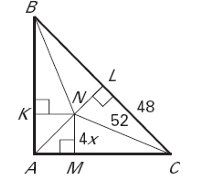
Solution :
Given that MN = 4x(Distance between angle bisector and one side)
MN = NL = KN = 4x
LC = 48, NC = 52, NL = 4x
In triangle NLC :
NC2 = NL2 + LC2
522 = (4x)2 + 482
2704 = 16x2 + 2304
2704 - 2304 = 16x2
16x2 = 400
x2 = 400/16
x2 = 25
x = 5
So, the value of x is 5.
Problem 5 :
Use the diagram below to answer the following questions. Point D is the incenter of ∆𝐴BC. Find the measures of h, k, m, w, x, y, and z.
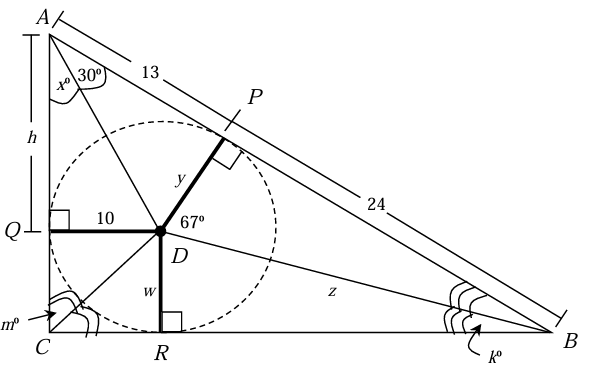
Solution :
Since DA is angle bisector, x = 30°
Since D is the incenter of the circle, QD = DP = DR
y = 10 and w = 10
In triangle PDB,
<PDB + <DBP + <BPD = 180
67 + k + 90 = 180
157 + k = 180
k = 180 - 157
k = 23
In quadrilateral QDCR,
QD = DR = CR= QC
<DCR = m = 25
In triangle APD,
AD2 = DP2 + PA2
AD2 = 102 + 132
AD2 = 100 + 169
AD2 = 269
In triangle AQD,
AD2 = AQ2 + QD2
269 = h2 + 102
269 - 100 = h2
h2 = 169
h = 13
In triangle DPB,
DB2 = DP2 + PB2
z2 = y2 + 242
z2 = 102 + 242
z2 = 100 + 576
z2 = 676
z = √676
z = 26
Problem 6 :
In the diagram below of isosceles triangle ABC, AB ≅ CB and angle bisectors AD, BF, and CE are drawn and intersect at X.
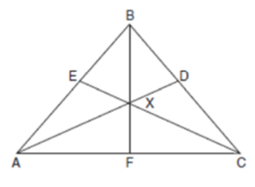
If m ∠BAC = 50°, find m ∠AXC
Solution :
m ∠BAC = 50°
AD is the angle bisector,
m ∠BAC/2 = 25°
m ∠DAC = 25° and m ∠XCF = 25°
m ∠AXC = 180 - (m ∠XAC + m ∠XCA)
m ∠AXC = 180 - (25 + 25)
m ∠AXC = 180 - 50
m ∠AXC = 130
Problem 7 :
In the diagram below, point B is the incenter of FEC, and EBR, CBD, and FB are drawn.
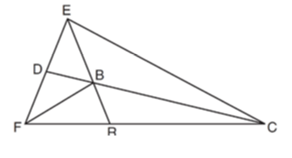
If m ∠FEC = 84 and m ∠ECF = 28, determine and state m ∠BRC.
Solution :
Since B is the incenter, then ER, DC and FB are angle bisectors.
m ∠FEC = 84, then m ∠FEB = <BEC = 42
m ∠ECF = 28, then m ∠ECB = <RCB = 14
In triangle ERC,
<REC + <ERC + <RCE = 180
42 + <ERC + 28 = 180
<ERC + (42 + 28) = 180
<ERC + 70 = 180
<ERC = 180 - 70
<ERC = 110 = <BRC
Problem 8 :
In the diagram below of ABC, CD is the bisector of ∠BCA, AE is the bisector of ∠CAB, and BG is drawn.
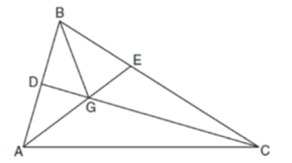
Which statement must be true?
a) DG = EG b) AG = BG c) ∠AEB ≅ ∠AEC
d) ∠DBG ≅ ∠EBG
Solution :
Since G is the incenter of the triangle. DG and EG are the distance between incenter and side of the triangle.
Recent Articles
-
Finding Range of Values Inequality Problems
May 21, 24 08:51 PM
Finding Range of Values Inequality Problems -
Solving Two Step Inequality Word Problems
May 21, 24 08:51 AM
Solving Two Step Inequality Word Problems -
Exponential Function Context and Data Modeling
May 20, 24 10:45 PM
Exponential Function Context and Data Modeling